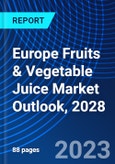This report comes with 10% free customization, enabling you to add data that meets your specific business needs.
1h Free Analyst TimeSpeak directly to the analyst to clarify any post sales queries you may have.
According to the research report, Europe Fruit and Vegetable Juice Market Outlook, 2028, the market is anticipated to grow by USD 9.84 Billion in size from 2023 to 2028. The fruit and vegetable juice market is growing due to busy work schedules and changing lifestyles, and the eating behaviour of consumers is also changing. The increasing trend of skipping meals is increasing the market for fruit and vegetable juices. The market is witnessing a rise in functional and specialty juices in Europe. Functional juices are formulated with added nutrients, botanicals, or other functional ingredients that provide specific health benefits. Specialty juices include exotic fruits, superfruits, and unique flavour combinations, appealing to consumers looking for novel taste experiences and additional health benefits. Fruit and vegetable juice are the types considered in this report, with fruit juice having the highest market share in this region. Orange juice is a classic and widely consumed fruit juice in Europe. It is favoured for its refreshing taste, high vitamin C content, and association with breakfast consumption. As well, multifruit blends, which combine various fruits into a single juice, are highly popular in Europe. These blends often feature combinations like apple, orange, pineapple, and other tropical fruits, offering a diverse flavour profile. In the future, vegetable juice is expected to grow at the highest CAGR rate. The growing focus on health and wellness among consumers in Europe has contributed to the increased demand for vegetable juices. Vegetables are known for their nutritional value, which includes vitamins, minerals, and antioxidants. Vegetable juices offer a convenient way to incorporate a variety of vegetables into the diet, providing a concentrated source of nutrients. There are several countries in Europe that provide the best vegetables and fruits for making juice. Spain is one of the largest producers of fruits and vegetables in Europe. It has a diverse agricultural sector that cultivates a wide range of crops, including citrus fruits (oranges and lemons), tomatoes, peppers, strawberries, and melons. Furthermore, Italy is renowned for its agricultural production, including fruits and vegetables. It is a major producer of tomatoes, citrus fruits (lemons and oranges), grapes, olives, and various vegetables such as artichokes and fennel.
There are several government initiatives and associations for the fruit and vegetable juice markets. Europe has several government associations and initiatives that support and regulate the fruit and vegetable juice market. The European Fruit Juice Association (AIJN) is the representative association of the fruit juice industry in Europe. It brings together national fruit juice associations and companies involved in the production, processing, and distribution of fruit juices. AIJN works to promote the interests of the European fruit juice industry and collaborates with stakeholders to ensure high-quality and safe products. The European Organic Juices Association (EOJA) represents the interests of the organic fruit and vegetable juice sector in Europe. It works to promote organic farming practises, advocate for organic certification standards, and support the market development of organic juices. Each European country may have its own national government associations and initiatives that support the fruit and vegetable juice market. These can include programmes to promote agricultural production, encourage sustainable farming practises, and provide funding or grants for research and development in the juice industry.
Based on the distribution channel segment, it includes supermarkets and hypermarkets, convenience stores, online, and others (cafés, clubs, restaurants, etc.). In Europe, hypermarkets and supermarkets account for the largest market share. Carrefour is a major retail chain with hypermarkets and supermarkets in multiple European countries. They typically offer a variety of fruit and vegetable juices from various brands and manufacturers. Also, there are various hypermarkets and supermarkets that offer fruit and vegetable juice, including Tesco, Lidl, Aldi, and Edeka. After hypermarket supermarkets, convenience stores are expected to grow at the highest CAGR rate. There are several convenience stores that offer a wide range of fruit and vegetable juices. There are several stores that offer fruit and vegetable juice, including 7-Eleven and Coop Convenience.
Considered in this report
- Geography: Europe
- Historic year: 2017
- Base year: 2022
- Estimated year: 2023
- Forecast year: 2028
Aspects covered in this report
- Europe Fruit & Vegetable Juice market with its value and forecast along with its segments
- Country-wise Fruit & Vegetable Juice market analysis
- Various drivers and challenges
- On-going trends and developments
- Top profiled companies
- Strategic recommendation
Countries covered in the report:
- Germany
- France
- UK
- Italy
- Spain
- Russia
By Type
- Fruit Juice
- Vegetable Juice
- Fruit & Vegetable blend
- Nectar
By Distribution Channel
- Supermarket/hypermarket
- Convenience Stores
- Online
- Others (Cafes, Clubs, Restaurant’s, Etc.)








